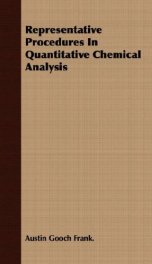representative procedures in quantitative chemical analysis

Representative Procedures in Quantitative Chemical Analysis BY FRANK AUSTIN GOQH Professor of Chemistry and Director of the Kent Chemical Laboratory in Yale University FIRST EDITION NEW YORK JOHN WILEY SONS, INC. LONDON CHAPMAN HALL, LIMITED 1916 PREFACE THIS introduction to representative procedures in quanti tative chemical analysis is an out-growth of long experience in the teaching of that subject. Inevitably it must reflect some characteristics of many predecessors, and to all of these the author desires to make every due acknowledgment of in debtedness. Procedures have been discussed in relation to their essential features, underlying principles, and varied applications. A large amount of space has been devoted to iodometric processes both on account of the beauty and accuracy of these methods, constantly growing in recognition, and because the treatment in the more elementary text-books is usually scanty. The arrangement of the subject matter is such as to permit the selection of a narrower course or a broader course, as may be desired, without detriment to the logical sequence of topics. Explicit directions are given for certain representative experi mental processes, but if wider practice is desired the general description of related processes should make it possible to adapt to these the specific directions given for the representative ex perimental processes. The value of collateral reading in stimulating interest and in amplifying information is recognized, and, inasmuch as access to the periodical literature is frequently difficult, refer ences in respect to further information have been made, so far as seemed practicable, to a few easily accessible books, in which further reference to original sources may usually be found, if needed. CONTENTS CHAPTER I PROCESSES OF ANALYSIS ANALYTICAL REACTIONS. The course of chemical action, 1 successive reactions, 3 non-reversible and reversible reactions, 4 velocity of non reversible reactions, 5 completion of reversible reactions, 6 the prin ciple of Le Chatelier, 9 empirical processes, 10. CHAPTER II PROCESSES OF WEIGHING AND MEASURING THE PROCESS OF WEIGHING. The analytical balance, 11 determina tion of the zero-point, 13 the operation of weighing, 14 the method of equal swings, 15 the method of oscillations, 16 the sensitiveness of the balance, 17 correction for inequality in the arms of the balance, 19 weighing by substitution, 19 double weighing, 19 correction for buoyancy of the air, 19. The analytical weights, 21 the testing of weights, 21. THE MEASUREMENT OF VOLUME. Volumetric apparatus, 24 varia tions of volume with changing temperature, 25 correction of the indi cated volume, 26 calibration of instruments, 28 of flasks, 29 of pipettes, 30 of burettes and divided pipettes, 30. CHAPTER III PROCEDURES IN GRAVIMETRIC ANALYSIS PREPARATION FOR WEIGHING. Air drying, 32 drying in desiccators, 33 dehydration by heat, 33. PROCESSES DEPENDING UPON THE FORMATION OF VOLATILE PRODUCTS. Determination of water of composition, 34 determination by loss on heating, 35 experimental process water in hydrous barium chloride, 35 determination by loss on heating with a flux, 36 experimental process water in hydrous copper sulphate, 36 determination by direct weighing, 36. Determination of carbon dioxide, 38 determination in VI CONTENTS carbonates by loss on heating, 38 experimental process carbon dioxide in calcite, 39 by loss on fusion with a flux, 39 experimental process carbon dioxide calcite, 40 by loss in the action of acid upon carbonates, 40 experimental process carbon dioxide in calcite, 41 by direct weigh ing, 42. Determination of carbon as carbon dioxide and hydrogen as water, by the combustion process, 44. Determination of boric acid, 44 use of calcium oxide as the retainer, 46 use of sodium tungstate as the retainer, 47...
Info about the book
Author:
Series:
Unknown
ISBN:
0543729591
Rating:
4.5/5 (5)Your rating:
0/5
Languge:
English
Users who have this book
Users who want this book
What readers are saying
What do you think? Write your own comment on this book!
write a commentGenre
if you like representative procedures in quantitative chemical analysis try:
Do you want to read a book that interests you? It’s EASY!
Create an account and send a request for reading to other users on the Webpage of the book!


